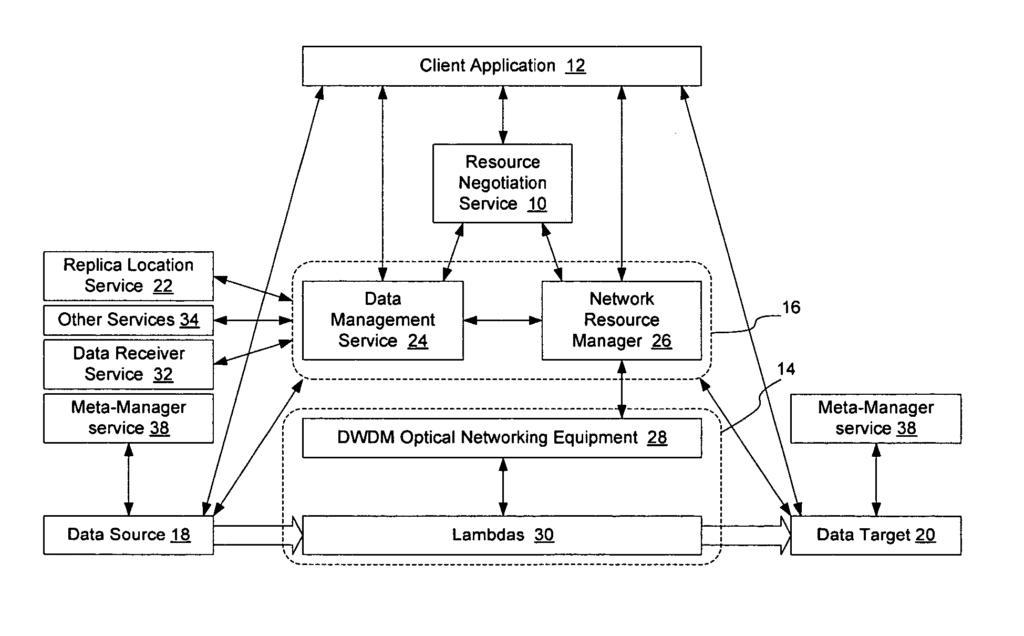ABSTRACT
A resource negotiation service is provided to enable business logic decisions to be made when obtaining switched underlay network resources, to interface business logic with network conditions and schedules.
The resource negotiation service may be implemented as a web service or other network service to enable business logic to be used in the selection of available network resources. This may allow policy to be used on both the subscriber side and the network provider side to optimize network resource allocations for a proposed transfer. The policy may include subscriber policy, network policy, and other factors such as current and expected network conditions. The resource negotiation service may include an interface to enable existing subscribers and new customers to obtain switched underlay resources.

Automated negotiation for resources on a switched underlay network
An Inventor: Dr. Tal Lavian
BACKGROUND
1. Field
-
This application relates to communication networks and, more particularly, to a method and apparatus for automated negotiation for resources on a switched underlay network.
2. Description of the Related Art
-
Data communication networks may include various computers, servers, nodes, routers, switches, hubs, proxies, and other devices coupled to and configured to pass data to one another. These devices will be referred to herein as “network elements,” and may provide a variety of network resources such as communication links and bandwidths. Conventionally, data has been communicated through the data communication networks by passing protocol data units (or cells, frames, or segments) between the network elements by utilizing one or more type of network resources. A particular protocol data unit may be handled by multiple network elements and cross multiple communication links as it travels between its source and its destination over the network.
- Conventional data networks are packet switched networks, in which data is transmitted in packet form which allows the packets to be commingled with other packets from other network subscribers. As the size of a data transfer increases in size, the ability to handle the data transfer on a packet network decreases. For example, a traditional packet switched network, such as a TCP/IP based communication network, will tend to become overloaded and incapable or inefficient at handling large data transfers. Thus, it is desirable, at least in large transfers, to obtain a dedicated path through the network to handle the transfer.
- Grid networks is one emerging application in which it may be desirable to obtain switched network resources to handle transfers between network participants. Grid networks is a technology that may be used to build an overlay network, i.e. a computational Grid, on an existing network infrastructure using Grid computing technology. In a Grid network, which forms a virtual organization, Grid nodes are distributed widely and share computational resources such as disk storage, storage servers, shared memory, computer clusters, data mining, and visualization centers, although other resources may be available as well. One example of Grids is the TeraGrid, in which Grid computing technology has been deployed to enable supercomputer clusters distributed in four distant locations in the United States to collaboratively work on computationally intense tasks, such as high-energy physics simulations and long-term global weather forecasting. Other potential uses for Grid computing include genomics, protein structure research, computational fluid dynamics, astronomy and astrophysics, Search for ExtraTerrestrial Intelligence (SETI), computational chemistry, “intelligent” drug design, electronic design automation, nuclear physics, and high-energy physics. Grid computing may be used for many other purposes as well, and this list is not intended to be inclusive of all possible uses.
- Some of these applications are or are expected to be capable of producing an incredible amount of data that will need to be distributed to other Grid applications for analysis. For example, high energy physics experiments expected to begin in 2007 are expected to produce data at a rate that may exceed one petabyte of data per year (1 petabyte=1000 Terabyte=1015bytes). This data will need to be sent to many different sites, such as research facilities and universities around the world, for analysis and storage.
- One technology that is capable of handling these large data transfers is the use of switched optical networking. Typically, each transfer, which is typically several hundred gigabytes to several terabytes in size, uses a dedicated switched optical link. These links are typically provisioned to operate at 10 gigabits/second over each dedicated wavelength (lambda), and multiple lambdas can be multiplexed together to provide bandwidth sufficient to transfer these vast quantities of data.
- Conventionally, the ability to obtain network resources of this nature has been governed by the implementation of a service level agreement between the subscriber and the network provider. Generation of a service level agreement involves the negotiation between representatives of each of the parties, which may be a time consuming and lengthy process. When the subscribers needs change, and a modification of the service level agreement is required, a re-negotiation of the service level agreement or amendment of the service level agreement is required. Conventionally this process has been time consuming and often would interject delays into obtaining network resources.